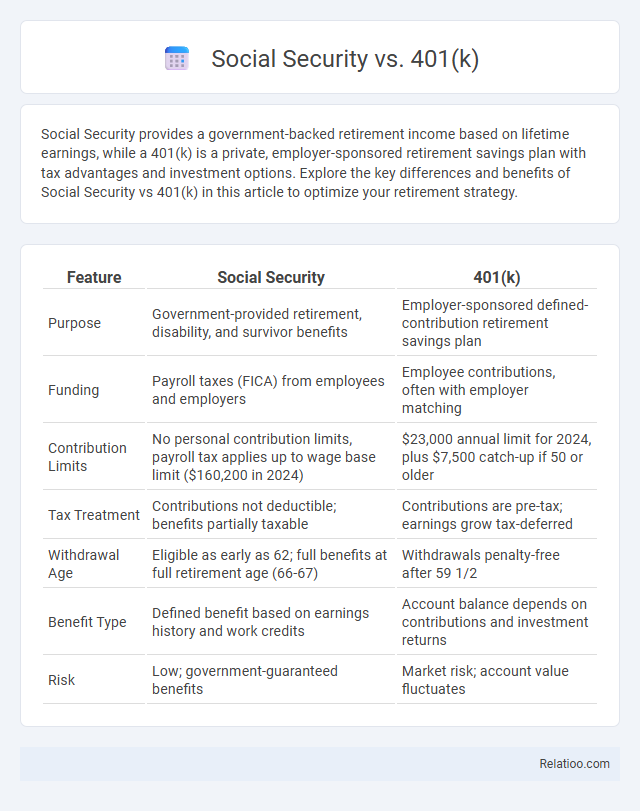Social Security provides a government-backed retirement income based on lifetime earnings, while a 401(k) is a private, employer-sponsored retirement savings plan with tax advantages and investment options. Explore the key differences and benefits of Social Security vs 401(k) in this article to optimize your retirement strategy.
Table of Comparison
| Feature | Social Security | 401(k) |
|---|---|---|
| Purpose | Government-provided retirement, disability, and survivor benefits | Employer-sponsored defined-contribution retirement savings plan |
| Funding | Payroll taxes (FICA) from employees and employers | Employee contributions, often with employer matching |
| Contribution Limits | No personal contribution limits, payroll tax applies up to wage base limit ($160,200 in 2024) | $23,000 annual limit for 2024, plus $7,500 catch-up if 50 or older |
| Tax Treatment | Contributions not deductible; benefits partially taxable | Contributions are pre-tax; earnings grow tax-deferred |
| Withdrawal Age | Eligible as early as 62; full benefits at full retirement age (66-67) | Withdrawals penalty-free after 59 1/2 |
| Benefit Type | Defined benefit based on earnings history and work credits | Account balance depends on contributions and investment returns |
| Risk | Low; government-guaranteed benefits | Market risk; account value fluctuates |
Introduction to Social Security and 401(k)
Social Security is a government-administered program providing retirement, disability, and survivor benefits funded through payroll taxes under the Federal Insurance Contributions Act (FICA). A 401(k) is an employer-sponsored retirement savings plan allowing employees to contribute pre-tax income, with potential employer matching and tax-deferred growth. Both Social Security and 401(k) plans serve as critical components of retirement planning, offering distinct benefits and risks depending on individual income, career longevity, and investment strategies.
Understanding Social Security: Benefits and Drawbacks
Understanding Social Security involves recognizing its role as a government-managed program providing guaranteed retirement income based on your work history and earnings, offering cost-of-living adjustments and spousal benefits. However, Social Security faces funding challenges with projected depletion of its trust funds by 2034, which may affect future benefit levels. Balancing Social Security with a 401(k) allows you to diversify retirement income sources, combining guaranteed benefits with potentially higher returns from private investments.
Overview of 401(k) Retirement Plans
401(k) retirement plans offer a tax-advantaged way to save for retirement through employer-sponsored accounts that allow you to contribute pre-tax dollars, reducing your taxable income. Contributions grow tax-deferred until withdrawal, usually at retirement age, supplementing Social Security benefits for a more secure financial future. Your ability to maximize 401(k) benefits depends on factors like employer matching contributions, investment choices, and contribution limits set by the IRS.
Eligibility Criteria: Social Security vs 401(k)
Social Security eligibility requires earning at least 40 credits through payroll taxes over approximately 10 years, with benefits based on lifetime earnings and age at retirement. In contrast, 401(k) eligibility depends on employer plan rules, often requiring a minimum service period or age, with contributions primarily from the employee and potential employer match. Understanding these criteria is essential for optimizing retirement planning by leveraging both Social Security and 401(k) benefits.
Contribution Limits and Funding Sources
Social Security is funded through payroll taxes with contribution limits set by the Social Security wage base, which is $168,600 in 2024, while your earnings above this amount are not taxed for Social Security. In contrast, 401(k) plans have annual contribution limits of $23,000 for individuals under 50 and $30,500 for those 50 or older in 2024, funded directly from your pre-tax salary deferrals, sometimes matched by your employer. Understanding these funding sources and contribution caps is crucial to optimizing your retirement savings strategy and ensuring a balanced approach between guaranteed Social Security benefits and tax-advantaged 401(k) growth.
Tax Implications: Comparing Social Security and 401(k)
Social Security benefits may be partially taxable depending on your total income, with up to 85% subject to federal tax if combined income exceeds certain thresholds. Contributions to a 401(k) plan are made pre-tax, lowering your taxable income now, but withdrawals during retirement are fully taxed as ordinary income. Understanding these tax implications helps you optimize Your retirement strategy by balancing immediate tax savings with potential future tax liabilities.
Withdrawal Rules and Access to Funds
Social Security benefits can typically be accessed starting at age 62, but withdrawing early reduces your monthly payments permanently, whereas 401(k) plans allow you to begin withdrawals penalty-free at age 59 1/2 with required minimum distributions starting at age 73. Unlike Social Security, 401(k) withdrawals are subject to income tax and may incur a 10% penalty if taken too early, but offer more flexibility in withdrawal amounts and timing. You should carefully evaluate your immediate financial needs against future income stability when deciding how to access funds from Social Security or a 401(k).
Risk Factors: Stability and Investment Performance
Social Security offers stable, government-backed benefits with minimal risk, ensuring predictable income regardless of market fluctuations. In contrast, 401(k) plans depend on investment performance, exposing participants to market volatility and potential losses, but with higher growth potential over time. Balancing Social Security's stability with 401(k) investment opportunities provides a diversified retirement strategy managing both consistency and growth risks.
Long-Term Retirement Planning Strategies
Long-term retirement planning strategies benefit from understanding the key differences between Social Security, 401(k) plans, and IRAs. Social Security provides a guaranteed lifetime income based on your earnings history, while 401(k) plans and IRAs offer tax-advantaged growth potential through diversified investments, allowing your savings to potentially outpace inflation. Combining these sources can maximize your retirement income, balancing the security of Social Security with the growth opportunities of employer-sponsored and individual retirement accounts.
Choosing the Right Retirement Option for You
Choosing the right retirement option involves evaluating Social Security benefits, 401(k) plans, and IRAs based on your financial goals, risk tolerance, and expected retirement timeline. Social Security provides a guaranteed lifetime income, while 401(k) accounts offer tax advantages and potential employer matching contributions but depend on market performance. Balancing these options with personal savings strategies ensures optimal income stability and growth throughout retirement.

Infographic: Social Security vs 401(k)
 relatioo.com
relatioo.com